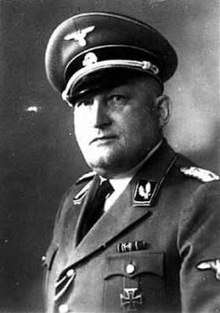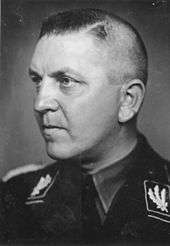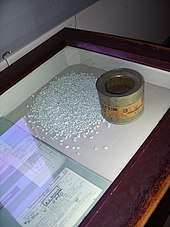Richard Glücks
![]()
Richard Glücks | |
|---|---|
 | |
| Born | 22 April 1889 Odenkirchen, German Empire |
| Died | 10 May 1945 (aged 56) Flensburg, Allied-occupied Germany |
| Allegiance | |
| Service/ | |
| Rank | SS-Gruppenführer and Generalleutnant of the Waffen-SS |
| Service number | NSDAP #214,855 SS #58,706 |
| Unit | SS-Totenkopfverbände |
| Battles/wars | World War I World War II |
| Other work | One of the primary organizers of The Holocaust. |
Early life
Glücks was born 1889, in Odenkirchen (now part of Mönchengladbach) in the Rhineland. Having completed gymnasium in Düsseldorf, he worked in his father's business, a fire insurance agency. In 1909, Glücks joined the army for one year as a volunteer, serving in the artillery. In 1913, he was in England, and later moved to Argentina as a trader. When World War I broke out, Glücks returned to Germany under a false identity on a Norwegian ship in January 1915 and joined the army again. During the war, he eventually became the commander of an artillery unit and was awarded the Iron Cross I and II.[1] Glücks fought at the Battle of Verdun and the Battle of the Somme.[2] After the war, he became a liaison officer between the German forces and the Military Inter-Allied Commission of Control, the allied body for controlling the restrictions placed upon Germany in the Treaty of Versailles regarding re-armament and strength of their armed forces. Until 1924, he stayed in that position, before joining the staff of the 6th Prussian Division. He also served in the Freikorps.[2]
Rise under the Nazi regime

Glücks joined the NSDAP in 1930 and two years later, the SS.[2] From 6 September 1933 to 20 June 1935 he was a member of the staff of the SS-Group "West" and rose to the rank of an SS-Sturmbannführer. While lacking in charisma, historian Nikolaus Wachsmann claims Glücks possessed an "abundance of ideological commitment."[3] On 1 April 1936 he became the chief of staff to Theodor Eicke, who was then Concentration Camps Inspector and head of the SS-Wachverbände.[2]
Concentration Camps Inspector
When Eicke became field commander of the SS Division Totenkopf during the summer of 1939, Glücks was promoted by Himmler on 15 November 1939 as Eicke's successor to the post of Concentration Camps Inspector.[4] As the Concentration Camps Inspector, Glücks was directly subordinate to Himmler—as Eicke had been—but, in contrast with the warm relation between Himmler and the older Eicke, Glücks only rarely met with Himmler, who promoted him not for his leadership competencies but for his ability to "provide the administrative continuity" with Eicke's policies.[3] Less a reflection of Glücks's energy and aptitude, his rise in power was more about Eicke's ineffectual managerial skill, according to historian Michael Thad Allen.[5] Glücks made few changes once taking over, leaving the organizational structure intact as Eicke had set it up; the same uncompromising rigidity was carried out at the camps—there was no rehabilitation and no effort to exploit the working potential of inmates.[6] Because Glücks never served inside a concentration camp, some senior camp members were suspicious and considered him nothing more than a desk-side bureaucrat.[3] In terms of his leadership style, he preferred men of action and allowed them some autonomy in operating their respective camps.[7] Historian Robert Lewis Koehl described Glücks as "unimaginative, lacking in energy if not lazy," and even "unperceptive," which may account to some extent for his hands-off approach.[8]

Glücks's responsibilities at first mainly covered the use of concentration camp inmates for forced labour. In this phase, he urged camp commandants to lower the death rate in the camps, as it went counter to the economic objectives his department was to fulfill. Other orders of his were to ask for the inmates to be made to work continuously. At the same time, it was Glücks who recommended on 21 February 1940, Auschwitz, a former Austrian cavalry barracks, as a suitable site for a new concentration camp to Himmler and Reinhard Heydrich.[9][10] Glücks accompanied Himmler and several chief directors of I.G. Farben on 1 March 1941 for a visit to Auschwitz, where it was decided that the camp would be expanded to accommodate up to 30,000 prisoners, an additional camp would be established at nearby Birkenau capable of housing 100,000 POWs, and that a factory would be constructed in proximity with the camp prisoners placed at I.G. Farben's disposal.[11]
On 20 April 1941 Glücks was promoted to the rank of an SS-Brigadeführer and in November 1943, Glücks was made SS-Gruppenführer and a Generalleutnant of the Waffen-SS.[12][13] From 1942 on, Glücks was increasingly involved in the implementation of the "Final Solution", along with Oswald Pohl. To oversee the coordination of camp related activities, which varied from the medical concerns of personnel and prisoners, the status of construction projects, and the progress of extermination operations, Glücks, along with other senior SS camp managers, attended weekly meetings conducted by Pohl.[14] Glücks never attempted to outshine his superior and was quite aware of his subordination to Pohl.[15]
Just a few days after the Wannsee Conference in January 1942, Himmler ordered Glücks to prepare the camps for the immediate arrival of 100,000 Jewish men and 50,000 women being evacuated from the Reich as labourers in lieu of the diminishing availability of Russian prisoners.[16] In February 1942, the CCI became "Amt D" of the Wirtschafts- und Verwaltungshauptamt (SS Economic and Administrative Department; WVHA) under SS-Obergruppenführer Oswald Pohl.[17] Glücks continued to manage the camp administration until the end of the war. Therefore, the entire concentration camp system was placed under the authority of the WVHA with the Inspector of Concentration Camps now a subordinate to the Chief of the WVHA.[18] By March 1942, Glücks was routinely receiving direct instructions from the head engineer and SS-General Hans Kammler, to meet the productivity demands of SS engineers.[19]
In July 1942, he participated in a planning meeting with Himmler on the topic of medical experiments on camp inmates.[20] From several visits to the Auschwitz concentration camps, Glücks was well aware of the mass murders and other atrocities committed there. Correspondingly, Auschwitz Kommandant Rudolf Höss routinely informed Glücks on the status of the extermination activities.[21] During one of his inspection-tour visits to Auschwitz in 1943, Glücks complained about the unfavorable location of the crematoria since all types of people would be able to "gaze" at the structures. Responding to this observation, Höss ordered a row of trees planted between Crematorias I and II.[22] When visits from high officials from the Reich or the Nazi Party took place, the administration was instructed by Glücks to avoid showing the crematorias to them; if questions arose about smoke coming from the chimneys, the installation personnel were to tell the visitors that corpses were being burned as a result of epidemics.[23]
Sometime in December 1942, after discovering 70,000 out of 136,000 incoming prisoners had died almost as fast as they arrived, he issued a directive to the camp doctors, which stated, "The best camp doctor in a concentration camp is that doctor who holds the work capacity among inmates at its highest possible level...Toward this end it is necessary that the camp doctors take a personal interest and appear on location at work sites."[19]
Before the death marches of early 1945 started, Glücks reiterated a directive from July 1944, which emphasized to camp commanders that during "emergency situations," they were to follow the instructions of the regional HSSPF (Höherer SS- und Polizeiführer) commanders.[24] Between 250,000 to 400,000 additional lives were lost as a result of these death marches.[25]
According to historian Leni Yahil, Glücks was "the RSHA man responsible for the entire network of concentration camps" and his authority extended to the largest and most infamous of them all, Auschwitz.[16] From what historian Martin Broszat relates, nearly all the important matters concerning the concentration camps were "decided directly between the Inspector of Concentration Camps and the Reichsführer-SS."[26] In January 1945, Glücks was decorated for his contributions to the Reich in managing the fifteen largest camps and the five-hundred satellite camps which employed upwards of 40,000 members of the SS.[27] Glücks' role in the Holocaust "cannot be over-emphasized" as he, together with Pohl, oversaw the entire Nazi camp system and the persecution network it represented.[9]

Death
When the WVHA offices in Berlin were destroyed by Allied bombing on 16 April 1945, the WVHA was moved to Born on Darß in Pomerania on the Baltic sea. Owing to the advances of the Red Army forces, Glücks and his wife fled to Flensburg.[9]
After the capitulation of Germany, he is believed to have committed suicide on 10 May 1945 by swallowing a capsule of potassium cyanide at the Mürwik naval base in Flensburg-Mürwik, although the lack of official records or photos gave rise to speculation about his ultimate fate.[9] There is suspicion that Jewish avengers may have killed Glücks for his role in the Final Solution.[28]
Fictional references
In the 1972 Frederick Forsyth novel The Odessa File and movie The Odessa File (film) loosely based on the novel Glücks is represented as still being alive and the Head of Odessa who is still determined to destroy the Republic Of Israel twenty years after the end of World War II. If the real Glücks had still been alive he would have been 74 years old in 1963.
See also
- List SS-Gruppenführer
- List of SS personnel
- Pohl Trial
Notes
- Hamilton 1996, p. 145.
- Wachsmann 2015, p. 193.
- Wachsmann 2015, p. 194.
- Wachsmann 2010, p. 26.
- Allen 2002, p. 41.
- Koehl 2004, p. 183.
- Wachsmann 2015, p. 195.
- Koehl 2004, p. 187.
- Hamilton 1996, p. 146.
- Snyder 1994, p. 117.
- Yahil 1990, p. 364.
- Wachsmann 2015, p. 399.
- Wistrich 2001, p. 76.
- Wachsmann 2015, p. 398.
- Wachsmann 2015, pp. 398–399.
- Yahil 1990, p. 315.
- Weale 2012, p. 115.
- Koehl 2004, pp. 182–183.
- Allen 2002, p. 150.
- Kogon 2006, p. 164.
- Tuchel 1994, p. 22.
- Hilberg 1985, p. 234.
- Hilberg 1985, p. 241.
- Friedländer 2009, p. 417.
- Black 2016, p. 112.
- Broszat 1968, p. 461.
- Yahil 1990, p. 542.
- Gilbert 1985, p. 811.
References
- Allen, Michael Thad (2002). The Business of Genocide: The SS, Slave Labor, and the Concentration Camps. London and Chapel Hill: The University of North Carolina Press. ISBN 978-0-80782-677-5.CS1 maint: ref=harv (link)
- Black, Jeremy (2016). The Holocaust: History and Memory. Bloomington; Indianapolis: Indiana University Press. ISBN 978-0-25302-214-1.CS1 maint: ref=harv (link)
- Broszat, Martin (1968). "The Concentration Camps, 1933–45". In Krausnick, Helmut; Buchheim, Hans; Broszat, Martin; Jacobsen, Hans-Adolf (eds.). Anatomy of the SS State. New York: Walker and Company. ISBN 978-0-00211-026-6.CS1 maint: ref=harv (link)
- Friedländer, Saul (2009). Nazi Germany and the Jews, 1933–1945. New York: Harper Perennial. ISBN 978-0-06135-027-6.CS1 maint: ref=harv (link)
- Gilbert, Martin (1985). The Holocaust: A History of the Jews of Europe during the Second World War. New York: Henry Holt and Company. ISBN 0-8050-0348-7.CS1 maint: ref=harv (link)
- Hamilton, Charles (1996). Leaders & Personalities of the Third Reich, Vol. 2. R. James Bender Publishing. ISBN 0-912138-66-1.CS1 maint: ref=harv (link)
- Hilberg, Raul (1985). The Destruction of the European Jews. New York: Holmes & Meier. ISBN 0-8419-0910-5.CS1 maint: ref=harv (link)
- Koehl, Robert (2004). The SS: A History 1919–45. Stroud: Tempus. ISBN 978-0-75242-559-7.CS1 maint: ref=harv (link)
- Kogon, Eugen (2006). The Theory and Practice of Hell: The German Concentration Camps and the System Behind Them. New York: Farrar, Straus and Giroux. ISBN 978-0-37452-992-5.CS1 maint: ref=harv (link)
- Snyder, Louis (1994) [1976]. Encyclopedia of the Third Reich. Da Capo Press. ISBN 978-1-56924-917-8.CS1 maint: ref=harv (link)
- Tuchel, Johannes (1994). Die Inspektion der Konzentrationslager, 1938–1945: Das System des Terrors (in German). Berlin: Hentrich. ISBN 978-3-89468-158-6.CS1 maint: ref=harv (link)
- Wachsmann, Nikolaus (2010). "The Dynamics of Destruction". In Jane Caplan; Nikolaus Wachsmann (eds.). Concentration Camps in Nazi Germany: The New Histories. New York: Routledge. ISBN 978-0-41542-651-0.CS1 maint: ref=harv (link)
- Wachsmann, Nikolaus (2015). KL: A History of the Nazi Concentration Camps. New York: Farrar, Straus and Giroux. ISBN 978-0-37411-825-9.CS1 maint: ref=harv (link)
- Wistrich, Robert (2001). Who's Who In Nazi Germany. New York: Routledge. ISBN 978-0-41511-888-0.CS1 maint: ref=harv (link)
- Yahil, Leni (1990). The Holocaust: The Fate of European Jewry. Oxford and New York: Oxford University Press. ISBN 0-19-504522-X.CS1 maint: ref=harv (link)
Further reading
- Holocaust Education & Archive Research Team (2009). "Richard Glucks as described by Rudolf Höss" at Holocaust Research Project.org.